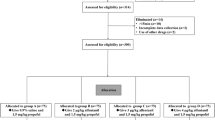Abstract
In paediatric patients, esophagogastroduodenoscopy (EGD) is commonly performed with the use of sedation. The aim of the study was to compare the effectiveness of propofol and midazolam in providing procedural amnesia and controlling behaviour in children undergoing diagnostic EGD. Children (9–16 years), classified to the first or second class of the American Society of Anaesthesiologists’ physical status classification referred for EGD, were randomly assigned to receive propofol with alfentanyl or midazolam with alfentanyl for sedation during the procedure. Within 120 min after the procedure, patients were repeatedly investigated for memory of the procedure and for memory of pain intensity during EGD with the use of the visual analogue scale. Activity and cooperation of the patient during the procedure was assessed with the relative adequacy scale. Of the 51 children, 48 completed the study. Propofol was significantly better than midazolam in inducing amnesia of procedural pain (mean difference 11.53 mm; 95 % confidence interval [CI] 0.96 to 22.10), loss of memory of the procedure (relative risk 0.4; 95 % CI 0.21 to 0.59) and controlling behaviour (relative risk 2.12; 95 % CI 1.33 to 3.36).
Conclusion: In children sedated for EGD, propofol is significantly better than midazolam at providing procedural amnesia and controlling behaviour during the procedure.
What is known: • There is still the matter of debate what is the most safe and effective way to provide sedation for paediatric esophagogastroduodenoscopy in children. |
What is new: • In children sedated for gastroduodensocopy propofol is significantly better than midazolam at providing amnesia, reported procedural pain and controlling behaviour during the procedure. |

Similar content being viewed by others
Abbreviations
- CI:
-
Confidence interval
- EGD:
-
Esophagogastroduodenoscopy
- MD:
-
Mean difference
- ML:
-
Midazolam
- PF:
-
Propofol
- RAS:
-
Relative adequacy scale
- RR:
-
Relative risk
- VAS:
-
Visual analogue scale
References
Alados-Arboledas FJ, Millán-Bueno P, Expósito-Montes JF, de la Cruz-Moreno J, Pérez-Parras A, Arévalo-Garrido A (2011) Safety and efficacy of continuous infusion propofol for diagnostic upper gastrointestinal endoscopy in spontaneous breathing. An Pediatr (Barc) 75:124–128
American Academy of Pediatrics, American Academy of Pediatric Dentistry, Coté CJ, Wilson S, Work Group on Sedation (2006) Guidelines for monitoring and management of pediatric patients during and after sedation for diagnostic and therapeutic procedures: an update. Pediatrics 18:2587–2602
Bailey B, Gravel J, Daoust R (2012) Reliability of the visual analog scale in children with acute pain in the emergency department. Pain 153:839–842
Blount R, Zempsky W, Jaaniste T, Evans S, Cohen L, Dvine K, Zeltzer L (2009) Management of pediatric pain and distress due to medical procedures. In: Roberts M, Steele R (eds) Handbook of pediatric psychology, 4th edn. Gilford Press, New York, pp 171–188
Chen PH, Wu TC, Chiu CY (2012) Pediatric gastrointestinal endoscopic sedation: a 2010 nationwide survey in Taiwan. Pediatr Neonatol 53:188–192
Dar AQ, Shah ZA (2010) Anesthesia and sedation in pediatric gastrointestinal endoscopic procedures: a review. World J Gastrointest Endosc 2:257–262
Elitsur Y, Blankenship P, Lawrence Z (2000) Propofol sedation for endoscopic procedures in children. Endoscopy 32:788–791
Howard R, Carter B, Curry J, Association of Paediatric Anaesthetists of Great Britain and Ireland (2012) Good practice in postoperative and procedural pain management, 2nd edition. Paediatr Anaesth 22(suppl 1):1
Kain ZN, Hofstadter MB, Mayes LC, Krivutza DM, Alexander G, Wang SM, Reznick JS (2000) Midazolam: effects on amnesia and anxiety in children. Anesthesiology 93:676–684
McGrath PJ, Walco GA, Turk DC et al (2008) Core outcome domains and measures for pediatric acute and chronic/recurrent pain clinical trials. J Pain 9:771–783
Oh JE, Lee HJ, Lee YH (2013) Propofol versus midazolam for sedation during esophagogastroduodenoscopy in children. Clin Endosc 46:368–372
Powell CV, Kelly AM, Williams A (2001) Determining the minimum clinically significant difference in visual analog pain score for children. Ann Emerg Med 37:28–31
Rafeey M, Ghojazadeh M, Feizo Allah Zadeh H, Majidi H et al (2010) Use of oral midazolam in pediatric upper gastrointestinal endoscopy. Pediatr Int 52:191–195
Squires R, Morriss F, Schluterman S, Krivutza DM, Alexander G, Wang SM, Reznick JS (1995) Efficacy, safety, and cost of intravenous sedation versus general anesthesia in children undergoing endoscopic procedures. Gastrointest Endosc 41:99–104
Tsao JC, Lu Q, Kim SC, Zeltzer LK (2006) Relationships among anxious symptomatology, anxiety sensitivity and laboratory pain responsivity in children. Cogn Behav Ther 35:207–215
van Beek EJ, Leroy PL (2012) Safe and effective procedural sedation for gastrointestinal endoscopy in children. J Pediatr Gastroenterol Nutr 54:171–185
Van Houten JS, Crane SA, Janardan SK, Wells K (1998) A randomized, prospective, double blind comparison of midazolam (Versed) and emulsifield diazepam (Dizac) for opioid-based, conscious sedation in endoscopic procedures. Am J Gastroenterol 93:170–174
Acknowledgments
We would like to thank Beata Korus our paediatric endoscopy nurse for her cooperation in performing this trial.
Conflict of interest
This work was funded by the Medical University of Warsaw. The authors declare that no financial or other conflicts of interest exist in relation to the content of the article.
Authors’ contribution
ES and PD initially conceptualised this study. All authors contributed to the study protocol. ES, JZ and PD were responsible for data collection, data analysis, data interpretation, and preparation of the report. AP contributed to data analysis and data interpretation. ES and PD assumed the main responsibility for the writing of the first draft of this manuscript. All authors contributed to (and agreed upon) the final version.
Author information
Authors and Affiliations
Corresponding author
Additional information
Communicated by Peter de Winter
Rights and permissions
About this article
Cite this article
Sienkiewicz, E., Albrecht, P., Ziółkowski, J. et al. Propofol-alfentanyl versus midazolam-alfentanyl in inducing procedural amnesia of upper gastrointestinal endoscopy in children—blind randomised trial. Eur J Pediatr 174, 1475–1480 (2015). https://doi.org/10.1007/s00431-015-2555-z
Received:
Revised:
Accepted:
Published:
Issue Date:
DOI: https://doi.org/10.1007/s00431-015-2555-z




